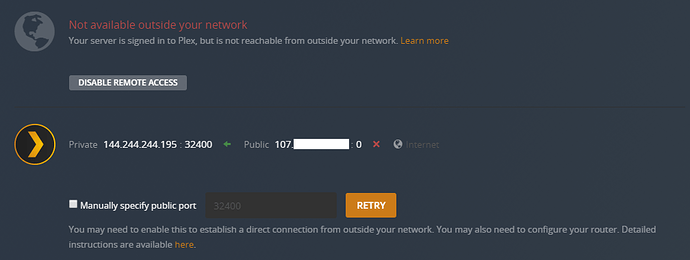@Aquaman and @anon18523487 – Hi! Thank you both so much for your help so far! I feel like we’re close to a solution here. I was able to do some more troubleshooting yesterday with some peculiar results.
When I toggle on enable remote access on my Plex server, this is what happens in the background:
Jan 02, 2022 18:40:02.773 [0x1504cdb14b38] DEBUG - MyPlex: Toggling server publish state.
Jan 02, 2022 18:40:02.773 [0x1504cdb14b38] DEBUG - MyPlex: start public ip check and mapping - current mapped state: 'Mapped - Not Published (Not Reachable)'.
Jan 02, 2022 18:40:02.773 [0x1504cdb14b38] DEBUG - MyPlex: mapping state set to 'Not Mapped'.
Jan 02, 2022 18:40:02.773 [0x1504cdb14b38] DEBUG - PublicAddressManager: Starting.
Jan 02, 2022 18:40:02.773 [0x1504cdb14b38] DEBUG - PublicAddressManager: Obtaining public address and mapping port.
Jan 02, 2022 18:40:02.773 [0x1504cc251b38] DEBUG - PublicAddressManager: Obtaining public IP.
Jan 02, 2022 18:40:02.773 [0x1504cc251b38] DEBUG - HTTP requesting GET http://plex.tv/pms/:/ip
Jan 02, 2022 18:40:03.099 [0x1504cc251b38] DEBUG - HTTP/2.0 (0.3s) 200 response from GET http://plex.tv/pms/:/ip
Jan 02, 2022 18:40:03.099 [0x1504cc251b38] DEBUG - PublicAddressManager: Got public IP from http://plex.tv: 107.X.X.X
Jan 02, 2022 18:40:28.713 [0x1504cc251b38] DEBUG - HTTP requesting GET https://107-X-X-X.[stuff].plex.direct:32400/identity
Jan 02, 2022 18:40:31.718 [0x1504cc251b38] DEBUG - MyPlex: Sending Server Info to myPlex (user=m*******************.com, ip=**[This is blank for some reason. Shouldn't my IP be listed here?]**, port=32400)
Jan 02, 2022 18:40:31.880 [0x1504cc251b38] DEBUG - MyPlex: Published Mapping State response was 201
Jan 02, 2022 18:40:31.880 [0x1504cc251b38] DEBUG - MyPlex: Got response for [stuff] ~ registered 107.X.X.X:32400
Jan 02, 2022 18:40:31.880 [0x1504cc251b38] DEBUG - MyPlex: updating mapped state - current state: 'Mapped - Not Published'
Jan 02, 2022 18:40:31.880 [0x1504cc251b38] DEBUG - MyPlex: mapping state set to 'Mapped - Publishing'.
Jan 02, 2022 18:40:31.880 [0x1504cc251b38] DEBUG - MyPlex: async reachability check - current mapped state: 'Mapped - Publishing'.
Jan 02, 2022 18:40:31.880 [0x1504cc251b38] DEBUG - MyPlex: Requesting reachability check.
Jan 02, 2022 18:40:37.171 [0x1504cc6d6b38] DEBUG - EventSource: Got event [data] '<Message address="107.X.X.X" port="32400" asyncIdentifier="[stuff]" connectivity="0" command="notifyConnectivity"/>'
Jan 02, 2022 18:40:37.171 [0x1504cc6d6b38] DEBUG - PubSub: Got notified of reachability for async identifier [stuff]: 0 for 107.X.X.X:32400 (responded in 5142 ms)
Jan 02, 2022 18:40:37.171 [0x1504cc6d6b38] DEBUG - MyPlex: reachability check - current mapping state: 'Mapped - Publishing'.
Jan 02, 2022 18:40:37.171 [0x1504cc6d6b38] DEBUG - MyPlex: mapping state set to 'Mapped - Not Published (Not Reachable)'.
(Some stuff has been sanitized above. Please let me know if I missed anything)
From the looks of it, Plex ends up pulling the correct public IP and tries to see it it’s reachable on port 32400, however it’s not. That led me to believe that maybe something was blocking the connection, so me and the admin took a look at it.
When it comes to the firewall, my understanding is that it is the first point of contact on the network and it handles NAT and port forwarding. My admin has stated that it is the only device that handles NAT so it shouldn’t be a double NAT situation. We did a packet trace for both the private (144.x.x.x) and public (107.x.x.x) address and external items are able to connect using port 32400, so the port isn’t blocked.
So we decided to try to connect to my server externally using Plex Web and the Plex IOS app and monitor the results. First, we tried monitoring the network for the worker IP addresses that Plex has here. But there was no connect attempt from any of them. We then decided to monitor port 32400 to see any connections, but nothing tried. The only way we were able to see a connection attempt is if I typed in my public IP and the Plex port in the device web browsers. (Like this: 107.x.x.x:32400)
Now we’re both a little confused. What method does Plex use to directly connect clients to my network? I though it used the public IP and Plex port, but now I don’t know.
As for both of your posts regarding my private (144.x.x.x) IP. I didn’t know that was an issue. Do you think it may be the reason why Plex isn’t showing a connection at all on the firewall?
Tl;dr – Plex pulls my public IP and tries to connect at port 32400, but says it’s not reachable. Packet tracing shows that it is reachable and when I try to connect to my server externally on the Plex web and IOS apps there is no hit on my firewall. How does Plex directly connect clients to my server?


